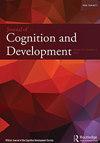证据是什么?证据信任与心理理论的关系
IF 1.6
2区 心理学
Q3 PSYCHOLOGY, DEVELOPMENTAL
引用次数: 0
摘要
摘要已有研究表明,心理动词和情态动词等语言线索会影响幼儿对举报人可靠性的判断。此外,某些语言包括语法语素(即证据标记),以澄清来自证词的信息的来源(例如,保加利亚语、日语、土耳其语)。因此,本研究的第一个目的是检验说土耳其语的儿童的可靠性判断是否会根据证据标记(即过去时直接证据标记-DI和过去时间接证据标记- mi)而改变。文献还研究了选择性信任能力是否与理解他人的认知状态(即心智理论)有关。因此,第二个目的是通过包括一个全面的汤姆能力电池来检查基于证据标记的选择性信任与汤姆能力之间的关系。86名居住在土耳其某大城市的4至7岁的土耳其语学龄前和小学儿童参加了基于证据标记的选择性信任任务、一般语言任务和汤姆电池组。本研究结果表明,6岁以后,说土耳其语的儿童开始选择性地信任使用过去时直接证据标记-DI的举报人,而不是使用过去时间接证据标记- miu。在控制了被试性别和年龄后,选择性信任表现与接受性词汇有关,而与汤姆行为能力无关。总的来说,研究结果有助于当前关于儿童基于语言线索的选择性信任能力及其与认知能力的关系的讨论。我们要感谢所有参与本研究的儿童及其家长以及幼儿园对数据收集的帮助。我们还要感谢匿名评论者提供的有用的评论和反馈。最后,非常感谢研究助理对研究的帮助。作者注意,第一作者是B. Çelik。和N. Ergut。数据收集和数据分析由B. Çelik和N. Ergut在J.W.P Allen的指导下进行。所有的作者都写了手稿。披露声明作者未报告潜在的利益冲突。数据可用性声明可应要求提供数据。注1还有另一种用于现行时的证据标记(-DIR),它允许说话者对事实和规律进行逻辑推断(有关土耳其语证据标记的更多类型,参见Aksu-Koç, Ögel-Balaban, & Alp, Citation2009)注意,外观-现实任务被排除在所有分析之外。有关详细信息,请参阅ToM结果部分在第二项研究中,另外两种情况进行了试点,其中直接证据标记与有来源的间接标记(例如,“最好的朋友”)进行了对比。这两个条件都是在当前信任任务完成后执行的80名大学生也以调查的形式参与了证据信任任务。结果显示,成年人明显更倾向于使用-DI的直接证据举报人,而不是使用- miei的间接证据举报人,t(79) = 10.548, p < 0.001(即,与预期一致,成年人认为使用-DI的直接证据举报人比使用- miei的间接证据举报人更可靠)。本文章由计算机程序翻译,如有差异,请以英文原文为准。
What’s the Evidence Say? The Relation Between Evidential-Trust and Theory of Mind
ABSTRACTPrevious research has shown that linguistic cues such as mental and modal verbs can influence young children’s judgments about the reliability of informants. Further, certain languages include grammatical morphemes (i.e. evidential markers), which clarify the source of information coming from testimony (e.g., Bulgarian, Japanese, Turkish). Accordingly, the first aim of the current study is to examine whether Turkish-speaking children’s reliability judgments change based on evidential markers (i.e. the past-tense direct evidential marker, –DI, and the past-tense indirect evidential marker, –mIş). The literature has also investigated whether selective trust abilities are related to understanding the epistemic states of others (i.e., Theory of Mind). Therefore, the second aim is to examine the relation between selective trust based on evidential markers and ToM abilities by including a comprehensive ToM battery. Eighty-six Turkish-speaking preschool and elementary school children between the ages of 4 and 7, residing in a metropolitan city in Turkey, participated in a selective trust task based on evidential markers, a general language task, and a ToM battery. The results of the current study showed that after the age of 6, Turkish-speaking children start to selectively trust the informant using the past-tense direct evidential marker, –DI, over the past-tense indirect evidential marker, –mIş. Selective trust performance was related to receptive vocabulary but not to ToM abilities after controlling for participant gender and age. Overall, the results contribute to current discussions about children’s selective trust ability based on linguistic cues and its relation with ToM.KEYWORDS: selective trusttheory of mindevidential markersreliabilityTurkish AcknowledgmentsWe would like to thank all of children and their parents who participated in this study as well as the preschools for helping with data collection. We would like to also thank the anonymous reviewers for helpful comments and feedback. Lastly, many thanks to research assistants for their help conducting the study.AuthorshipNote that the first authorship is shared by B. Çelik. and N. Ergut. Data collection and data analyses were performed by B. Çelik and N. Ergut under the supervision of J.W.P Allen. All authors wrote the manuscript.Disclosure statementNo potential conflict of interest was reported by the authors.Data availability statementData can be made available on request.Notes1 There is also another evidential marker (–DIR) used for the present tense and allows speakers to make a logical deduction about facts and regularities (for more on the types of evidential markers in Turkish, see Aksu-Koç, Ögel-Balaban, & Alp, Citation2009).2 Note that the appearance-reality task was excluded from all analyses. See ToM results section for details.3 Two additional conditions were piloted for a second study in which the direct evidential marker was pitted against the indirect marker with a source (e.g., “best friend”). Both of these conditions were conducted after the current trust task was completed.4 Eighty college-aged adults also participated in the evidential-trust task in a survey format. The findings revealed that adults significantly preferred the direct evidential informant using, –DI over the indirect evidential informant using, –mIş, t(79) = 10.548, p < 0.001 (i.e., in accordance with expectations, adults found the informant with the direct evidential marker, –DI more reliable than the informant with the indirect evidential marker, –mIş).
求助全文
通过发布文献求助,成功后即可免费获取论文全文。
去求助
来源期刊

Journal of Cognition and Development
Multiple-
CiteScore
4.00
自引率
0.00%
发文量
29
期刊介绍:
The Journal of Cognition and Development is the official journal of the Cognitive Development Society (CDS). Some CDS members are concerned with basic research or theory; others focus on policy issues and practical applications. The range of interests includes cognitive development during all stages of life, and we seek to understand ontogenetic processes in both humans and nonhumans. Finally, their interests encompass typical as well as atypical development, and we attempt to characterize both biological and cultural influences on cognitive change and continuity.
 求助内容:
求助内容: 应助结果提醒方式:
应助结果提醒方式:


